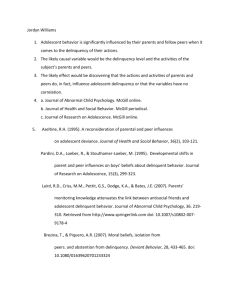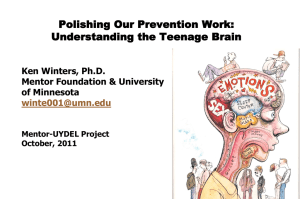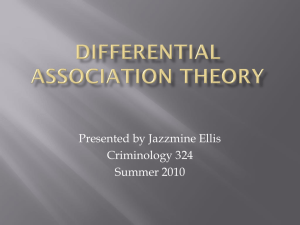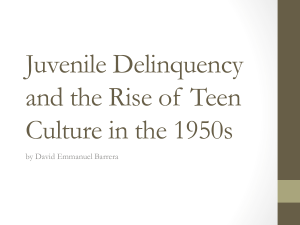Blog final unit2 fi 112
advertisement
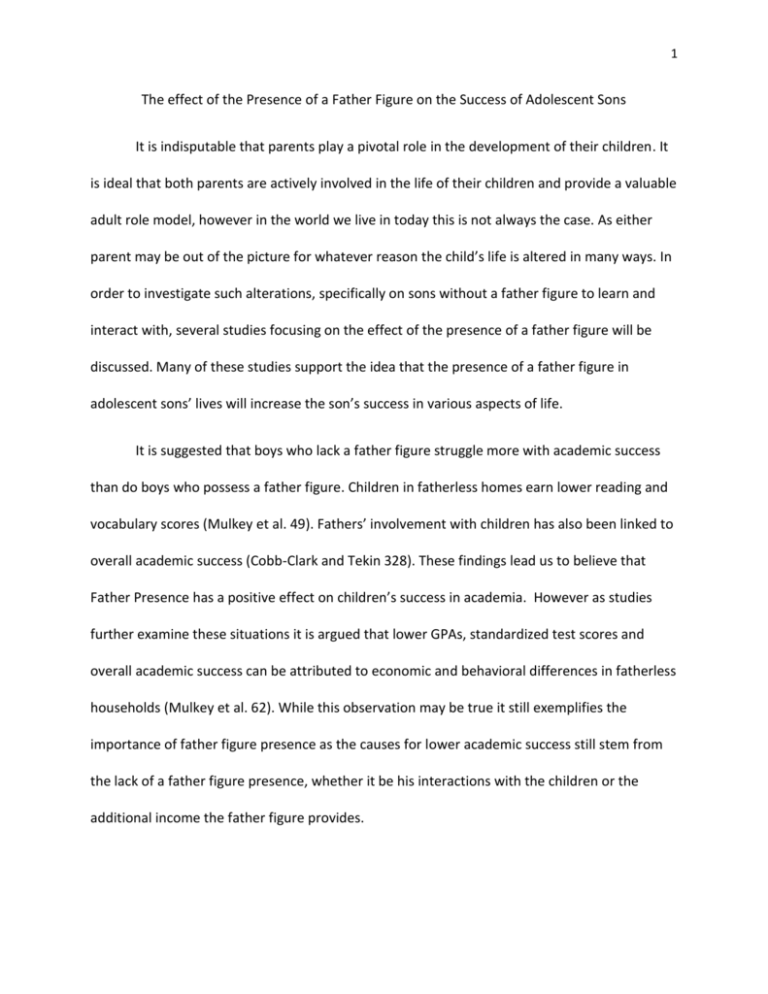
1 The effect of the Presence of a Father Figure on the Success of Adolescent Sons It is indisputable that parents play a pivotal role in the development of their children. It is ideal that both parents are actively involved in the life of their children and provide a valuable adult role model, however in the world we live in today this is not always the case. As either parent may be out of the picture for whatever reason the child’s life is altered in many ways. In order to investigate such alterations, specifically on sons without a father figure to learn and interact with, several studies focusing on the effect of the presence of a father figure will be discussed. Many of these studies support the idea that the presence of a father figure in adolescent sons’ lives will increase the son’s success in various aspects of life. It is suggested that boys who lack a father figure struggle more with academic success than do boys who possess a father figure. Children in fatherless homes earn lower reading and vocabulary scores (Mulkey et al. 49). Fathers’ involvement with children has also been linked to overall academic success (Cobb-Clark and Tekin 328). These findings lead us to believe that Father Presence has a positive effect on children’s success in academia. However as studies further examine these situations it is argued that lower GPAs, standardized test scores and overall academic success can be attributed to economic and behavioral differences in fatherless households (Mulkey et al. 62). While this observation may be true it still exemplifies the importance of father figure presence as the causes for lower academic success still stem from the lack of a father figure presence, whether it be his interactions with the children or the additional income the father figure provides. 2 Mental health is also an aspect of life that the presence of a father figure could affect. Eirini Flouri and Ann Buchanan conducted a study on the progression of children without a father figure, in which they questioned the children at three points throughout their lives, once at age seven, again at age sixteen and yet again at age thirty three (65). This study found that the presence of a father figure did not determine psychological maladjustment however found that the presence of a father figure proved to play a protective role against psychological maladjustment (Flouri and Buchanan 75). This protective role shown in a slight decrease in psychological maladjustment in children who possessed a father figure from those who did not possess a father figure. While father figure presence was not thought to accurately predict psychological maladjustment as many fatherless children grow up to be healthy adults, the fact that it proved to be a protective factor suggests that the presence of a father figure does increase, though not overwhelmingly, the likelihood of good mental health in children. The social success of adolescent sons is also suspected to be influenced by the presence of a father figure. As a positive male role model would, in theory, provide an adolescent son with an example of how social interactions should be handled, it is reasonable to believe that the presence of a father figure would speed and overall increase social success. In Scelza’s perhaps unorthodox study conducted on a group of indigenous hunter gatherers in Australia known as the Martu Arborigines, she found evidence supporting such a claim (296). As Scelza observed a ritual that signified the emergences of boys as men she found that those with a father figure, be it the biological father or other, completed the ritual at a younger age and in turn married and began a family at a younger age (299). While this study was not conducted on 3 individuals of a modern society it still provides insight into the ability that a father figure possesses to influence the social actions of adolescent sons. Drug abuse and delinquency is largely thought to be a result of the lack of a father figure presence. Studies such as that done by Cobb-Clark and Tekin proves this idea to be true. “Adolescent boys who have a father figure in their life are significantly less likely to engage in subsequent behavior” (Cobb-Clark and Tekin 336). This would seem to be obvious, since a father figure serves in many cases as a disciplinary figure; however, in a similar study conducted by Friedman, Ali, and McMurphy the opposite was found to be true as the sons of mother only households reported less illegal activity than sons of two parent households (93). These contradictory findings provide an interesting dilemma. Friedman, Ali, and McMurphy concede in their study that the results were dependent on the response set of the subjects and that it may be possible that the sons of mother only households simply failed to report illegal activity and did not actually participate in less illegal activity (94). The effects of the presence of a father figure range across a multitude of aspects of life, so many that it would be near impossible to measure all of them. However when focusing on the delinquency, academic success, social success, and mental health of the adolescents, the presence of a father figure clearly increases the overall success of adolescent sons. Though the evidence is not overwhelming and in many cases is minimal, it is existent and for the most part suggests that a son with a present father figure benefits in many ways. Works cited 4 Cobb-Clark, Deborah, and Erdal Tekin. “Fathers and youths’ delinquent behavior.” Review of Economics of the Household 12.2 (2013): 327-358. QuestPro. Web. 20 Oct. 2015. Flouri, Eirini, and Ann Buchanan. “The role of father involvement in children’s later mental health” Journal of Adolescence 26.1 (2003): 63-78. Science Direct. Web. 20 Oct. 2015. Friedman, Alfred, Asad Ali, and Suzanne McMurphy. “Father Absence as a Risk Factor for Substance Use and Illegal Behavior by Adolescent Sons.” Journal of Child and Adolescent Substance Abuse 8.2 (2009): 79-95. Taylor and Francis Online. Web. 20 Oct. 2015. Scelza, Brooke A. “Fathers' Presence Speeds the Social and Reproductive Careers of Sons.” Current Anthropology 09.20 (2010): 295-303. JSTOR. Web. 20 Oct. 2015 Mulkey, Lynn, Robert L. Crain, and Alexander J. C. Harrington. “One-Parent Households and Achievement: Economic and Behavioral Explanations of a Small Effect.” Sociology of Education 65.1 (1992): 48-65. JSTOR. Web. 20 Oct. 2015 Annotations: 5 Source 1: Cobb-Clark, Deborah, and Erdal Tekin. “Fathers and youths’ delinquent behavior” Review of Economics of the Household 12.2 (2013): 327-358. QuestPro. Web. 20 Oct. 2015. History of the search: This article was found using the VCU libraries portal then through the QuestPro Database. Search terms used included Fathers, Youths, and Delinquency. This article addressed the effect of father figures on the delinquency of youth which is a point of focus in my research paper making it an ideal source. Identification and Justification: We know this piece of work to be a Scholarly article for several reasons including the fact that both authors have earned their doctorates and are affiliated with universities, the article was published in the Review of Economics of the Household journal, and the Article has a sufficient amount of references. Summary: In the scholarly article “Fathers and youth's’ delinquent behaviors” by Deborah CobbClark and Erdal Tekin, the issue of father presence and resulting youth delinquency is addressed and discussed for other sociologists and individuals concerned with the effects of fathers on youth delinquency. By applying an equation that accounts for many variables such as family income, number of siblings, standard demographic controls (age, race, gender, etc.) and father involvement with the results of a study on a sample of adolescents in both one and two parent households obtained from the National Longitudinal Study of Adolescent Health (Add Health), conducted by the Carolina Population Center at the University of North Carolina at Chapel Hill, 6 the researchers were able to obtain values for delinquency in the various groups observed. Add Health contained several questions used to determine delinquent behavior including questions of property crime, violent crime, selling drugs, and gang fights in the past 12 months. These indications of delinquency were compared to father and mother involvement, family income, aspects of family structure, and whether the adolescent lived with biological or step parents in order to obtain data on the causes of delinquency. After examining the results focusing on the tendency to participate in delinquent behaviors the study found a correlation between father presence and son delinquency. It was found that the presence of the father and not so much the involvement of the father played a role in sons’ delinquent behavior. The study also found that father figure presence to have an effect on adulthood delinquency. When studying the effect of father presence on daughters’ behaviors was not noticeably correlated with delinquent behavior. The study also found a decreased tendency to participate in delinquent behaviors as an adult when a male lived with his biological father. This article claims that the presence of a father figure, and not the involvement or financial contributions of the father figure decreases delinquent behaviors of sons both in youth and as an adult. This claim is supported by the study done on the Add Health data. Source 2: Flouri, Eirini, and Ann Buchanan. “The role of father involvement in children’s later mental health” Journal of Adolescence 26.1 (2003): 63-78. Science Direct. Web. 20 Oct. 2015. History of search: This article was found using the VCU portal then through the Science Direct database. Search terms Father figure and children were used to locate this source. This 7 article examined an interesting aspect of the effect of father figure presence being mental health which applied well to my research paper. Identification and Justification: This is a scholarly article as it was published by the Journal of Adolescence, written by professors associated with universities, and contains a sufficient number of references. Summary Eirini Flouri and Ann Buchanan argue that father involvement in adolescence has a negative correlation with psychological maladjustments in adolescents’ adulthood in their Scholarly article “The role of father involvement in children’s later mental health”, written in the Journal of adolescence. This article is written primarily for psychologists and other scholars concerned with the effects of a father figure. The argument is supported by a study conducted based on data collected by the NCDS in the UK, consisting of responses from the mother and teacher on father involvement, and responses from the adolescents on psychological distress. Data compiled on subjects at age 7, 16, and 33 were analyzed for the study. After correlations between father involvement at a young age and adult psychological distress at an older age the study found father involvement to have a significant protective role against psychological maladjustments in later years, though father involvement did not accurately predict psychological maladjustment in later years. The study conceded because many of the more disadvantaged participants were lost in later years the results may be biased against the more extreme situations. The study may also be biased to mothers’ perception of father involvement as the data came solely from the responses of mothers and teachers. As Flouri and Buchanan 8 examine the effects of father figure presence on the mental health of adolescence they argue that the presence of a father figure does not accurately predict psychological maladjustments but did provide a valuable protective role against psychological distress later in life. This claim is supported by a study done on data collected by the NCDS and provides insight into the values of a father figure. Source 3: Friedman, Alfred, Asad Ali, and Suzanne McMurphy. “Father Absence as a Risk Factor for Substance Use and Illegal Behavior by Adolescent Sons.” Journal of Child and Adolescent Substance Abuse 8.2 (2009): 79-95. Taylor and Francis Online. Web. 20 Oct. 2015. History of Search: This source was found using the Taylor and Francis online database searching terms such as Father, absence and adolescence. This source addressed the effect of father figure presence has on adolescent delinquency which correlated perfectly with my research question. Identification and Justification: This source is a scholarly article based on the evidence that it was written by individuals who have earned PhDs and are associated with universities, the article was published by the Journal of Child and Adolescent Substance Abuse and contains a sufficient number of references. Summary: 9 The scholarly article “Father absence as a risk factor for substance abuse and illegal behavior by the adolescent sons” by Alfred Friedman, Asad Ali, and Suzanne McMurphy explores the idea that a fatherless son is more likely to participate in illegal activities such as substance abuse and drug trafficking. This article is intended for scholars and other professionals concerned with the effect of a father figure on delinquency in adolescence. In order to explore this topic a study was carried out on two groups of inner city court adjudicated male adolescent referred by the Family Court of Philadelphia, the first in a mother only household the second in a two parent household with a father figure, be it either a biological father or a stepfather. After asking a series of questions to these young men including drug use and drug trafficking questions four out of five comparisons reflected no correlation between fatherless adolescents and delinquent acts but instead found the opposite to be true, that those with only a mother reported less drug related activities. The article claims that this skewed result could be due to a lower open communication score for those with only a mother and in turn may have simply failed to report as much as those with both parents. The article concluded that even considering the lack of open communication skills of the mother only participants, no correlation could be made with the presence of a father figure and delinquent behaviors. With the claim that father figure presence has no impact on adolescent delinquency Friedman and company have provided a counter argument to most articles on the topic. Source 4: 10 Scelza, Brooke A. “Fathers' Presence Speeds the Social and Reproductive Careers of Sons.” Current Anthropology 09.20 (2010): 295-303. JSTOR. Web. 20 Oct. 2015 History of Search: This article was found using the VCU search Portal then through the JSTOR database. Search terms such Father, presence, and son were used. Identification and Justification: This is a scholarly article based on the evidence that it is written by an assistant professor at the University of California, published by the Current Anthropology journal and has a sufficient number of references. Summary: In the scholarly article “Father's’ presence speeds the social and reproductive Careers of sons”, published in “Current Anthropology”, by Brooke Scelza it is argued that the presence of a biological father speeds the social and reproductive success of sons. The study is written to argue the importance of a father figure in the social success of adolescent boys to human behavioral ecologists and other scholars concerned with the effects of a father figure on adolescents. The study is based on data gained on a group of indigenous hunter gatherers in Australia known as the Martu Arborigines. It focused on an initiation ritual that includes the circumcision of teenaged boys. The ritual occurs annually and the participation of young men is dependent on the decisions of elders and the ability for the boy to have a close relative, often a father, collect the required resources and payment. Initiated men are given the promise of a future wife and the ability to reproduce as well as other rights to respect. Three groups were studied, the first focused on all relatives including father mother grandfather etc., the second focused on fathers and father figures, the third on young men without a biological father. A strong correlation was found between the presence of a father and the time of initiation thusly affecting time of reproduction, suggesting that the presence of a father greatly increased the success of adolescence 11 reproduction and social activities. Though not conducted on a modern population, this study reveals the importance of a father figure across many different cultures. Source 5: Mulkey, Lynn, Robert L. Crain, and Alexander J. C. Harrington. “One-Parent Households and Achievement: Economic and Behavioral Explanations of a Small Effect.” Sociology of Education 65.1 (1992): 48-65. JSTOR. Web. 20 Oct. 2015 History of Search: This article was found as it was cited in another article “The role of father involvement in children’s later mental health” by Flouri and Buchanan. This article addressed the effects the presence of a father figure and provided a counter argument in behavioral and economic effects. This counter argument made it an ideal source for my research question. Identification and Justification: This article is a scholarly article as it is written by professors who have earned PhDs and are associated with universities, it was published by the journal Sociology of education and has a sufficient number of sources. Summary: The scholarly article “One parent Households and Achievement: Economic and Behavioral Effects of a small effect”, Published in Sociology of Education in 1992, by Lynn Mulkey, Robert Crain, and Alexander Harrington argues that the decline in standardized test scores and GPAs associated with one family homes can be attributed to a child's behavior and economic opportunities to some extent. This article is intended to provide a counter argument to the idea that academic success is dependent on the presence of both parents to scholars and other individuals concerned with the effect of parents’ presence on children's’ academic success. A 12 study was conducted accounting for low income homes and children with behavioral problems. The study focused on groups who had either a two parent household, a father only household, or a mother only household. While the children of one parent households do average lower GPAs and standardized test scores, the difference can be explained by lower income of one parent households and behavioral problems resulting from the leniency of one parent households. The difference between Father only households and mother only households were found to be only slightly different as after the elimination of confounding variables such as race and economic opportunities father absent houses had no real effect and mother absent houses only a small decline in academic performance. Though this source is slightly dated it serves to provide a valuable view on the issue of father figure presence. Reflective Memo After the unit one project I considered three fitting topics for the unit two paper being: gun rights in the United States, the effect of hunting at a young age on children, and the effect of a father figure on the success of adolescents. After reviewing my options I decided on the third option due mostly to my truly valued relationship with my own father. My research topic remained the same through the entire project, beginning to end. The most beneficial sources came from looking up referenced papers in the first couple of sources I found. These sources proved to be well correlated with my topic though they did not come up with the search terms I was using. I struggled with incorporating the evidence derived from the sources into a wellorganized paper and with simply grinding through what proved to be a massive and time consuming project. If I had more time I would spend it searching for more fitting, and more recent sources as the Mulkey source is slightly dated and the Scelza source is not conducted on 13 the most preferable population for my research question. I would also spend more time developing my argument and researching the counter arguments listed in the paper.
